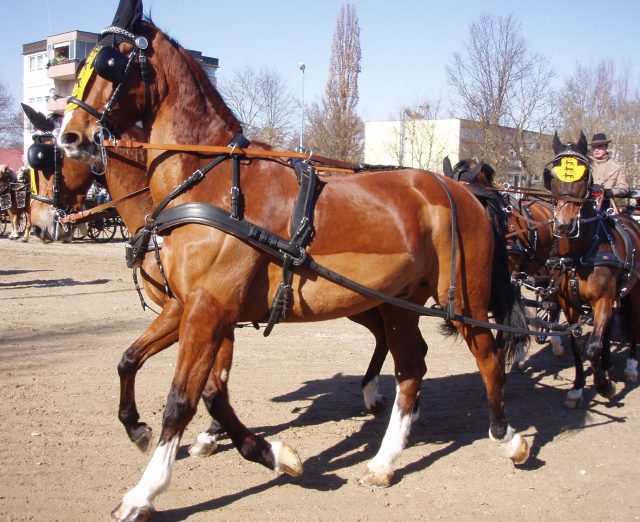Type the name of the breed you're looking for below
[wpdreams_ajaxsearchlite] Don't see the breed your're looking for? Click here and let us know!
Gelderland horse
| Country Of Origin | Netherlands |
| History and Background | The Gelderland, or Gelderlander, is a heavy warmblood breed of horse that was developed in the province of Gelderland in the Netherlands. The Gelderlander, along with the similar Groninger horse from the north, provided the foundation for the Dutch Warmblood. Originally bred to be a stylish carriage horse versatile enough to work on the farm, the Gelderlander declined in popularity in the middle of the 20th century. Today the breed is registered in a separate studbook of the Royal Warmblood Horse Studbook of the Netherlands (KWPN). This warmblood horse originated in the sandy province of Gelderland in the Netherlands. Native mares of this province were crossed with Andalusian, Neapolitan, Norman, Norfolk Roadster, and Holstein stallions to produce the Gelderland (also known as the Gelderlander). In the nineteenth century, other breeds were introduced, such as the East Friesian, Oldenburg, Hackney, and Thoroughbred. Today the Gelderland is used as a carriage driving horse and as a show jumper. It has an effective high stepping trot. Times changed and the Groningen horse became less of an essential element of agriculture, while recreational, competitive riding sports gained popularity. Initially, breeders had tried to develop the riding-type characteristics within the Gelderlander breed, but progress was too slow. The "sportregister" was for part-Gelderlander horses, crossed with more modern horses from other regions in hopes of creating what the market demanded: an agricultural riding horse. The Selle Francais stallion L'Invasion and Holsteiner Normann were imported by Gelderland breeders in hopes of speeding up this process. They were followed by Amor and Cavalerist from Holstein, Eclatant from Hannover, and Artilleur from France. In 1964 the VLN, which at the time managed the Gelderlander studbook, opened a "sportregister." The sportregister was for half-Thoroughbreds. Crossed back to a Gelderlander or Groningen, the offspring of a sportregister horse was allowed to be registered as purebred Gelderlander. These partbreds were so successful that the demand for them soon surpassed the demand for purebreds. Licensing champion Eufraat, by a son of L'Invasion, lost his breeding approval in 1976 because he was deemed too heavy. In 1969 the VLN and the Groningen register (NWP) merged to form the Royal Warmblood Horse Studbook of the Netherlands. Three registries were formed within it: one for riding horses, which are better known as Dutch Warmbloods, one for the Dutch harness horse and one for the "Gelderlander Versatility Horse." All of the Groningen stallions lost their breeding approval, and the KWPN recommended that Gelderlander mares be bred with foreign stallions to obtain the appropriate riding horse type. For a time the Gelderlander registry was discontinued, and though it is back in the KWPN today, breed enthusiasts fear that the population is too small. |
| Use Today | Pack animal, Riding horse, Light agricultural work, Harness horse |
| Height | 15.2 to 16 hands high (60.8-66.4 inches, 154-159 centimeters) |
| Colour | Bay, Black, Chestnut, Grey |
| Characteristics | The Gelderland usually comes in solid colours, though some have distinctive markings on the forehead. It has an elongated head and brawny neck; meanwhile, its withers, which are slightly broad, connect with the shoulders at a slight angle, though still in proportion with the neck and chest, which is broad. The Gelderland also has strong legs, supple joint, and tough, well-formed hooves. |
| Personality and Temperament | The Gelderland exudes sophistication, intelligence, and gentleness. Aside from being docile, it is recognized for its determination. |
| Other Considerations | The Gelderlander today is promoted as a versatile, family-friendly horse. The breed is a dominant force in the sport of combined driving, for which they are well-suited. However, many Gelderlanders - and especially their progeny - have competed in dressage and show jumping at the international level. An early top jumper was Gondelier, the 1972 Dutch Jumping Champion, who cleared 2.20 meters (about 7'3"). One of the top Gelderlander dressage horses was Zooloog, a Gondelier son, who was also sold to the United States, the flag of which he represented at the 1991 Pan American Games. One of the greatest qualities of the Gelderlander is their longevity and soundness. For example, Vosmaer, a Gelderlander stallion, was still competing in Grand Prix dressage at age 20. |



